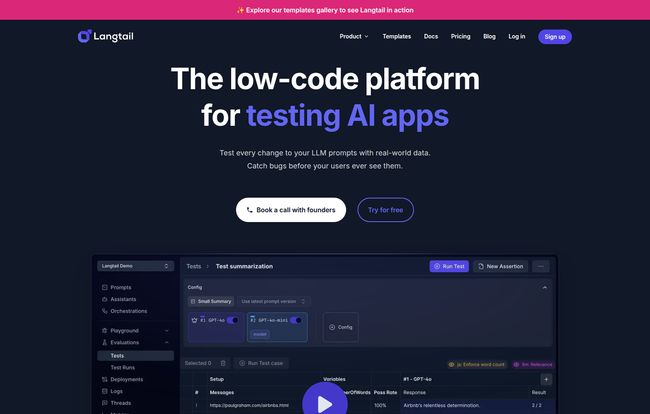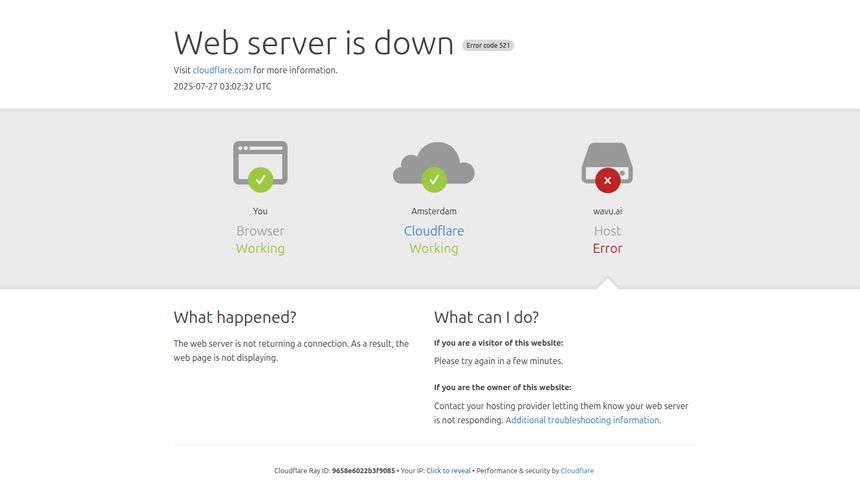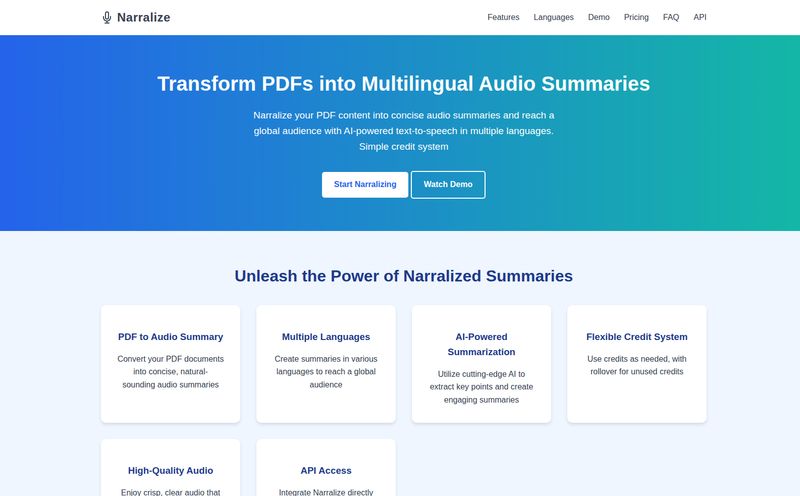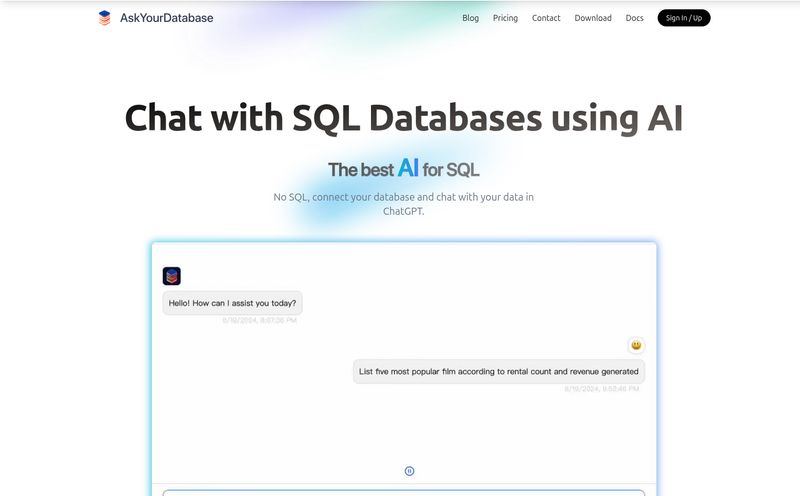Building with Large Language Models is… chaotic. It’s like trying to direct a blockbuster movie where your lead actor is a brilliant, improvisational genius who sometimes decides, mid-take, to start reciting Shakespeare in Klingon. You get moments of pure gold, and moments of “what on earth just happened?” The unpredictability is both the magic and the migraine.
For years, we in the trenches—the developers, the product people, the SEOs trying to leverage this stuff—have been wrestling with this. We cobble together spreadsheets, run endless manual tests, and cross our fingers every time a user interacts with our AI-powered feature. It often feels more like alchemy than engineering. So when a tool comes along promising to put us “back in control,” my ears perk up. That tool is Langtail, and I’ve been kicking its tires to see if it lives up to the hype.

Visit Langtail
So, What is Langtail, Really?
Strip away the jargon, and Langtail is essentially a command center for your LLM applications. It’s a low-code platform designed to help you build, test, and debug your AI products without wanting to tear your hair out. Think of it as a sophisticated sandbox where you can see exactly how your AI behaves before you let it loose in the wild. You can poke it, prod it, and run it through a gauntlet of tests to find its breaking points. The core idea is to move from guesswork to data-driven development. A concept I can definitely get behind.
The “low-code” part is the real kicker here. It means you don’t need to be a Python wizard with a PhD in machine learning to get value from it. The interface looks a lot like a spreadsheet, which is instantly familiar and way less intimidating than a blank terminal screen.
The Unpredictable Beast of LLM Outputs
The central problem Langtail tackles is the one we all know too well: LLM outputs are a moving target. What worked perfectly yesterday might give you a bizarre, off-brand response today. This makes building a reliable product a huge challenge. How do you ensure your customer service bot doesn't suddenly become rude? Or that your content generator doesn’t start spewing nonsense? This is where Langtail rolls up its sleeves.
The Spreadsheet-Style Testing Arena
The first thing that caught my eye is the testing interface. It’s set up like a table where you can create a bunch of different test cases. You can plug in different variables, try out various prompts, and see the outputs side-by-side. You can even compare responses from different models, like GPT-4 vs. Claude 3. This is huge for A/B testing prompts and finding the most effective, cost-efficient model for your needs. It turns the messy process of prompt engineering into something far more structured and, frankly, sane.
Your Personal AI Bouncer: The AI Firewall
Now this is a feature that gets me excited. The Langtail AI Firewall is designed to be a security guard for your app. It sits between the user and your LLM, watching for trouble. We're talking about things like prompt injection attacks, where a malicious user tries to trick your AI into ignoring its instructions. It also helps prevent the leakage of personally identifiable information (PII) and blocks the generation of unsafe or toxic content.
In my experience, many teams are so focused on getting the AI to work that they bolt on security as an afterthought. Langtail bakes it right into the workflow, which is how it should be. It’s a seriously important feature, especially for anyone building public-facing applications.
Keeping Your Prompts in a Row
If you've ever worked on a project with more than one prompt, you know how quickly things can get disorganized. Which version of the prompt produced the best results? What did we change last Tuesday? Langtail offers a kind of version control for your prompts and model settings. This means you can experiment freely, knowing you can always roll back to a version that worked. It’s a simple concept, but it's a lifesaver for collaborative projects, preventing that dreaded “who changed the master prompt?!” moment.
A Peek at the Price Tag: Langtail's Tiers
Alright, let's talk money. A tool can have all the bells and whistles in the world, but if the price is wrong, it’s a non-starter. Langtail has a pretty standard tiered approach, which seems designed to scale with you.
| Plan | Price | Best For | Key Features |
|---|---|---|---|
| Free | $0 / month | Small projects & hobbyists | Unlimited users, 2 prompts, 1,000 logs/month |
| Pro | $99 / month | Solopreneurs & freelancers | 1 user, 20 prompts, unlimited logs |
| Team | $499 / month | Growing teams & startups | 10 users, unlimited prompts, alerts, support |
| Enterprise | Custom | Large organizations | Unlimited everything, AI Firewall, self-hosting |
The Free tier is genuinely useful. It's not one of those crippled free trials. You get unlimited users (which is wild) and enough logs to get a real feel for the platform on a small project. The Pro plan seems perfect for a dedicated solo dev or a freelancer building AI apps for clients. The jump to the Team plan at $499 is significant, but it makes sense when you consider it’s for 10 users and unlocks collaboration-focused features like alerts and dedicated support. For big companies, the Enterprise plan offers the full suite, including the AI Firewall and the option to self-host, which is critical for organizations with strict data privacy requirements.
What I Genuinely Like (and What Gives Me Pause)
No tool is perfect, right? After spending time with Langtail, here's my breakdown.
I absolutely love the accessibility. The low-code, spreadsheet-like approach is brilliant. It opens up LLM development to a wider audience, including product managers, QA testers, and even us SEO folk, who can now more easily experiment with AI-driven content workflows. The focus on security with the AI Firewall is also a massive plus. It shows they're thinking about the real-world problems of deploying AI.
On the flip side, the pricing jump from Pro to Team might be a bit steep for some smaller startups that are just beginning to scale. And while the Enterprise option to self-host is fantastic, it does mean your team needs the technical chops to manage and maintain that infrastructure. It’s not a one-click install, and that’s an important consideration.
The Final Word on Langtail
So, is Langtail the control panel for LLMs we've all been hoping for? I'd say it's one of the strongest contenders I've seen. It doesn't try to be a magical, one-click solution. Instead, it provides a robust, well-thought-out set of tools that bring much-needed structure and security to the beautifully chaotic world of AI development.
If you're a solo developer just starting to build with AI, the free and pro tiers are incredibly compelling. If you're part of a team that's serious about shipping a reliable AI product, Langtail could save you countless hours of manual testing and debugging. It’s a tool that acknowledges the complexity of working with LLMs and gives you a fighting chance to tame the beast. And for that, it gets a solid nod of approval from me.
Frequently Asked Questions about Langtail
Can I actually use Langtail for free?
Yes, you absolutely can. The Free plan is quite generous, offering unlimited users and 1,000 logs per month for up to two prompts or assistants. It’s a great way to test the core functionality for a personal project or to see if the workflow fits your team before committing to a paid plan.
What exactly does the AI Firewall do?
Think of the AI Firewall as a security layer that protects your LLM application. It's designed to automatically block common attacks like prompt injection (where users try to hijack your AI), detect and redact sensitive data like names and phone numbers (PII), and prevent the model from generating inappropriate or harmful content. It's available on the Enterprise plan.
Does Langtail only work with OpenAI's models?
Nope! While it works great with OpenAI models like GPT-4, Langtail is designed to be model-agnostic. It integrates with major LLM providers, including Anthropic (Claude) and Google (Gemini). This lets you test different models against each other to find the best one for performance, cost, and quality for your specific use case.
Is Langtail difficult to use if I'm not a developer?
It's one of the more accessible tools out there. The core testing interface is designed to look and feel like a spreadsheet, which most people in a tech company are familiar with. While a developer will be needed to integrate the Langtail SDK into your application's code, the process of creating tests, evaluating results, and managing prompts can easily be handled by product managers, QA teams, or anyone comfortable with a spreadsheet-like UI.
What happens if I go over my plan's log limits?
On the Free plan, if you exceed the 1,000 logs per month, your logging will likely be paused until the next billing cycle. For paid plans like Pro and Team, you get unlimited logs, so you don't have to worry about hitting a ceiling. This is a key reason to upgrade once your application starts seeing real user traffic.



